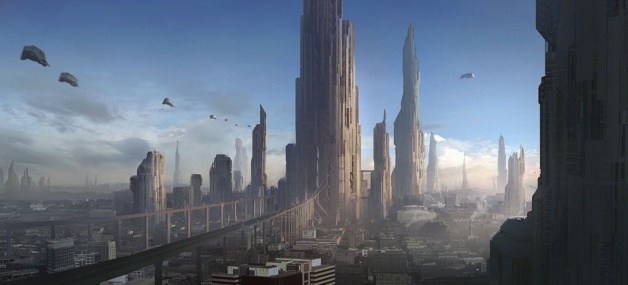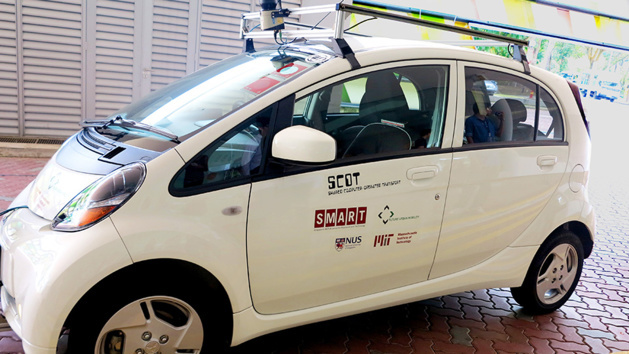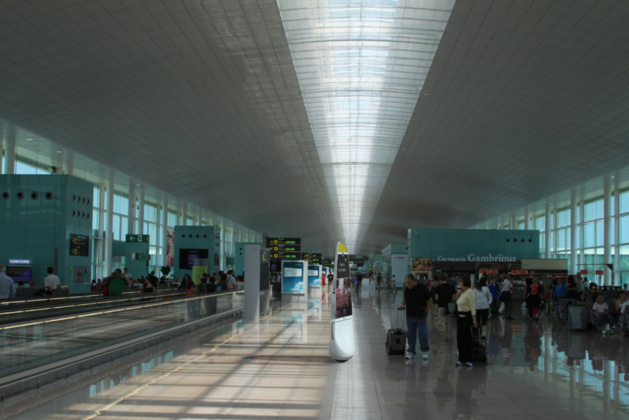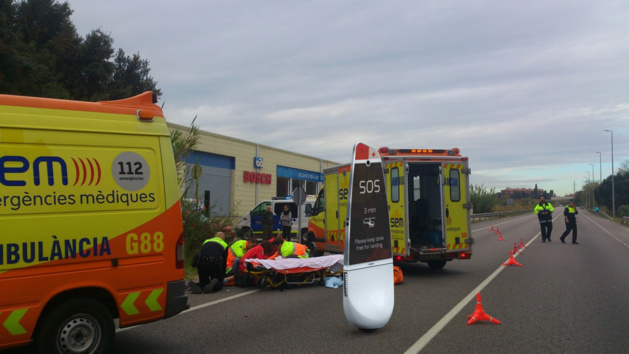
Credits : RR
The evolution of our cities faces new environmental issues, and one of the six main questions of the convention might find a solution in robotics. Although numerous evolved technologies already exist in environments specifically adapted to their limits, such as factories and assembly lines, their integration to our daily lives and our streets remains more complex. The considerable challenges lie in the unpredictable and changing nature of the human environment. “Robotics shall evolve in an area conceived for humans, not for robots” Marcelo Ang claims, from the university of Singapore. This scientist at SMART, Singapore-MIT Alliance for Research and Technology, shares his idea of what the future will bring.
Some projects could help creating entire cities that would respond to both human needs and robotic requirements. In the United Arab Emirates, green city Masdar has been under construction since 2008, and enjoys the pure frame of a desert area in order to adapt buildings to the current lifestyle from the very start. However, despite the various possibilities these cities might offer to test the efficiency of these technologies, they would not be able to serve as a role model for the rest of the world. Indeed, our European cities are ill-suited to these innovations, and are handicapped by their historical legacy. The key would be to adapt to the existing environment, respecting the restrictions it imposes: a delicate operation.
Transport issues
“Public transport has a direct impact on stress and quality of life” Marcelo Ang says. Yet, while the global population condenses into urban areas, it is very likely that our transport networks will not be able to provide for the citizens. Currently, traffic in cities is congested, in spite of the numerous improvements brought to public transportation. SMART Lab found an ecological and practical solution to this issue: smart automatized cars. Its name is SCOT, Shared Computer Operated Transport, a shared vehicle with a computerized pilot.

Credits : SMART Lab
The prototypes the research team tested already in Singapore are tiny, and look like golf carts. All you need is to tell the car your destination so it calculates, like a real taxi driver, the best itinerary depending on a highly scalable database. Each vehicle is constantly connected to the city’s environment and adapts its itinerary to the constraints related to traffic. “Singapore is ideal to test this kind of products, because it always welcome more and more inhabitants. But because of its space restraints, it will not be able to host all their personal-use vehicles.” In 2011, the urban population had grown to 5 184 000, using 956 704 vehicles. According to Marcelo Ang’s estimations, 300 000 smart cars would suffice to satisfy such a population.
Super-connected cities
This way of transportation is perfectly safe, thanks to a system made of sensors called LIDAR, enabling vehicles to apprehend their environment. SCOT can therefore avoid fixed and mobile obstacles, and is independent from the GPS signal to travel. It is an undeniable feature, for example in order to travel under a tunnel. When it comes to pedestrians, a system is able to anticipate their trajectory so it can adapt the car’s and avoid collision. SMART scientists affirm the automatized car does not get tired, its reflex is reliable and faster, also it does not get upset while driving and its angle of vision is wider. In addition to a solution to rush hours, it offers its passengers facilities: a vehicle they will not need to park, and that can be useful to other people when they do not need it anymore, instead of leaving it unused in a car park.
For its part, Massachusetts MIT SENSEable City Lab suggests the introduction of a smarter traffic, with interconnected automatized cars so every travel would be conceived to optimize traffic fluidity. This way, at intersections, traffic lights would end up useless: each vehicle’s speed would adapt so everyone can pass without collisions or having to slow down brutally. Our current cars started a few years ago to collect information in their immediate environment: temperature measurement, or even maneuvers without intervention of the driver. The difference with the smart car lies in the fact this precious information is stocked and shared once collected. Thanks to the acknowledgement of real-time traffic, it is a gain of time and a reduction of the amount of stress for its passengers, and of the pollution rate.
In Copenhagen, bikes represent 70 % of the traffic. The city is seen as one of the most environment-friendly of Europe, and to justify its reputation, a new project is born: Copenhagen Wheel. This bike, with a price just as futuristic as its design, is as a matter of fact a true pathfinder that saves multiple data along its travels in the streets of Copenhagen, such as pollution and humidity rate, or the quality of the soil. Incidentally, it can evaluate as well the intensity of the efforts provided by the cyclist and their caloric expenditure. This data can be anonymously transmitted to the city hall with the owner’s permission, in order to deduce evolutionary map of the streets conditions. The city of tomorrow thinks of itself and optimize endlessly its inhabitants’ mobility.
“Smart cities depend on the citizens’ intelligence”
According to MIT SENSEable City Lab, the success of the smart cities project relies on the reactions of their people. Nonetheless, the human being would have everything to gain by embracing such automatized technologies. Most of actual drivers hardly picture their vehicle without having immediate control over it, a behaviour that does not serve to project. According to a study led by the lab, the amount of stress and “road rage” - or anger of the driver – released during a travel downtown is tremendous. Human fallibility is superior to a mechanic one, and their reflexes are slower. As a conclusion, it is more trust worthy to let ourselves be guided, at least for travels in town.
Generalizing smart vehicles would participate in the integration of people with reduced mobility or incapable of driving. These all-terrain vehicles, from roads to paths exclusively pedestrian, this type of cars would be a solution to the “last mile problem”, qualifying the distance between an individual and the closest collection point: bus stop, bicycle or subway station. Indeed, smart cars would be able to cover all the distance necessary to our moves, from A to Z.
The city of the future would not resolve car traffic issue only, but also regulate human traffic. MIU, the Mobile Information Unit, uses the same interconnection system within urban area to help reduce congestion in very touristic or frequented areas. Blake MacEldowney from ZINC, a research laboratory specialized in design and innovation, introduced this novelty. The research team plans to include its invention to Barcelona, the city where they are located. The city, considered an attractive place to live by its people, has won such a reputation of being a great tourist attraction that the daily quality of life has lowered.
Travels are made more difficult because of important human fluctuation and locals react badly to the presence of mass tourism. MIU is a mobile and polyvalent kind of human size numerical information panel. They collect, transmit and recept various information about the city, the way bicycles do in Copenhagen.

Credit : ZINC
This very sophisticated robotic tool symbolizes an interface between the city and the human being. If needed, it can inform the crowds about a localized even in a little used place to try to lead the human flux out of an over-crowded area. MIU became the ambassador within the city and permits to override an “informational gap”, according to Blake MacEldowney. The latter senses a daily introduction to these panels in our cities, as a reliable tool for communication and identification. Finally, MIU can extend its scope for action beyond communicational limits and bring its support in particular cases, such as traffic accidents, where it can regulate the traffic in a zone, or help facilitate human fluctuation in airports.

Credit : ZINC
Depending on the point of view adopted, one could almost believe that robotics is over assisting us. Although everyone is free to have their own opinion, one of the technologies introduced during the conference is the perfect example of the case where robots put themselves to our use to avoid the least disturbance: SkyCall app. It is no longer about moves in the city, but internal orientation within a closed space. Let us take the example of the labyrinthine centre of MIT.
Imagine: you just arrived in this prestigious place of new technologies and you do not know where to go within the numerous buildings. You have class, you are late, and the only information you have is a classroom number. In this situation, an ordinary individual would waste their time turning around, vainly try to find a map, or would even take the risk of asking their way to someone in a rush and not collaborative, who does not speak their language anyway. The future student will only need to contact SkyCall, using their smartphone. A drone would then literally fly to their rescue and, once aware of the destination, would invite them to follow it. The itinerary will have been calculated to be as fast as possible depending on the frequentation of the place and potential slowdowns in the hallways. You can also benefit from comments from the drone, like a touristic guide, that will tell you everything about the places you pass.
Truly at the service of the human being, SkyCall is a proof of improvement regarding the comfort that robotic technologies bring to our daily life. At first sight, it can seem secondary; it is possible to extend these simple principles in situations where their use is essential, vital even. In this case, one could picture SkyCall robots guiding victims from catastrophes out of areas out of reach for the man, or helping visually impaired people to localize in an unknown environment.
Like these drones, the city of tomorrow is conceived to adapt to personal expectations, providing for everyone, and optimizing space and resources. What we call utopic might eventually take shape thanks to the progress of robotics.































